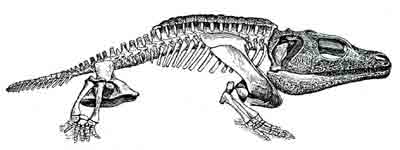Rare! Fossil Jaw with Teeth Primitive Giant Amphibian mm 10 x 4 x 2 Cacops morrisi Labyrinthodonts Extinct Temnospondyls Paleozoic Permian Collecting Paleontology Museum.
Remarkable representative collectible fossil specimen (ring of passage between Amphibians and Reptiles) difficult to find and of excellent quality, perfectly preserved. Maxillary portion with Teeth, rare species known only from two localities.
No restored at all. Only a piece, as in photos.
Cacops (Williston, 1910) was an amphibian (Amphibia, Temnospondylia, Dissorophoidea, Dissorophidae) now extinct belonging to the order of Temnospondiles, lived at the beginning of the Permian (about 275 million years ago) in North America.
The global geography of the first Permian included vast areas of land and water, with the earth's crust plates still merged together forming a supercontinent known as Pangea. In the lower Permian the climate began to become drier and
more amphibians evolved to become fully terrestrial animals. This is the case of the dissorophids (Dissorophidae), to which the Cacops belongs (whose name means "ugly appearance"). Three species are known of this animal: Cacops aspidephorus of Texas, C. woehri and C. morrisi, of Oklahoma. Cacops morrisi is named in honor of Tony Morris, who discovered one of his two specimens. The three species differed for some characteristics, first among all the teeth, suggesting that they had a different prey spectrum.
Probably this animal was fed by small vertebrates or insects, which hunted by actively moving on the ground. It is also believed that they hunted at night, to avoid the biggest predators. Cacops must have been
one of the amphibians of the period less dependent on the aquatic environment and probably in its habitat it was one of the greatest predators of its time.
This animal is one of the most distinctive Paleozoic amphibians that have diversified

in the equatorial region of Pangea during the Kungurian phase of the ancient Permian. It was about 40 centimeters long and had a stocky body supported by strong legs. The body was crossed by a
heavy armor along the back, formed by
osteoderms. These are associated only with the first 15 vertebrae; all internal osteoderms are fused to the neuronal spines. The portions of the vertebral column with osteoderms had a reduced lateral flexion, thus limiting lateral movement. Cacops may have had the chance to go on with short runs. However, he was not able to jump because of his short hind legs. He could also have used a symmetrical walk similar to modern crocodiles or salamanders, in which his body is supported by opposing movements of the front and back limbs. The tail was short and
the skull was huge, with large orbits and big jaws. The skull of Cacops has several characteristics associated with predatory behavior. The margina
l teeth are curved and thinner than other teeth. The palatal dentition consists of both curved tusks larger than the marginal teeth and robust curved teeth covering most of the palatal surface.
Furthermore, the skull of Cacops had a deep otic incision in the posterior part; this incisura, unlike many other similar amphibians, was closed by a bony bar. Recent findings described in 2009 thus provide the oldest evidence of a
tympanic membrane, typical of terrestrial vertebrates, suitable for hearing high-frequency aerial sounds. Among modern amniotes, sensory perception requires a specialized middle ear that collects sounds dispersed in the air through a tympanic membrane and transmits vibrations to the inner ear through multiple structures, including the bracket. Therefore, the discovery of a
thin bracket in Cacops suggested that it had
the ability to hear sound in the air, perhaps differently from today's vertebrates. This type of hearing is important for both prey detection and intraspecific communication.



